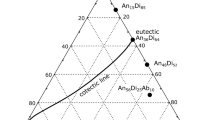Abstract
The speciation of CO2 in dacite, phonolite, basaltic andesite, and alkali silicate melt was studied by synchrotron infrared spectroscopy in diamond anvil cells to 1,000 °C and more than 200 kbar. Upon compression to 110 kbar at room temperature, a conversion of molecular CO2 into a metastable carbonate species was observed for dacite and phonolite glass. Upon heating under high pressure, molecular CO2 re-appeared. Infrared extinction coefficients of both carbonate and molecular CO2 decrease with temperature. This effect can be quantitatively modeled as the result of a reduced occupancy of the vibrational ground state. In alkali silicate (NBO/t = 0.98) and basaltic andesite (NBO/t = 0.42) melt, only carbonate was detected up to the highest temperatures studied. For dacite (NBO/t = 0.09) and phonolite melts (NBO/t = 0.14), the equilibrium CO2 + O2− = CO3 2− in the melt shifts toward CO2 with increasing temperature, with ln K = −4.57 (±1.68) + 5.05 (±1.44) 103 T −1 for dacite melt (ΔH = −42 kJ mol−1) and ln K = −6.13 (±2.41) + 7.82 (±2.41) 103 T −1 for phonolite melt (ΔH = −65 kJ mol−1), where K is the molar ratio of carbonate over molecular CO2 and T is temperature in Kelvin. Together with published data from annealing experiments, these results suggest that ΔS and ΔH are linear functions of NBO/t. Based on this relationship, a general model for CO2 speciation in silicate melts is developed, with ln K = a + b/T, where T is temperature in Kelvin and a = −2.69 − 21.38 (NBO/t), b = 1,480 + 38,810 (NBO/t). The model shows that at temperatures around 1,500 °C, even depolymerized melts such as basalt contain appreciable amounts of molecular CO2, and therefore, the diffusion coefficient of CO2 is only slightly dependent on composition at such high temperatures. However, at temperatures close to 1,000 °C, the model predicts a much stronger dependence of CO2 solubility and speciation on melt composition, in accordance with available solubility data.














Similar content being viewed by others
References
Bassett WA, Shen AH, Bucknum M, Chou IM (1993) A new diamond-anvil cell for hydrothermal studies to 2.5 GPa and from −190 °C to 1200 °C. Rev Sci Instr 64:2340–2345
Blank JG, Brooker RA (1994) Experimental studies of carbon dioxide in silicate melts: solubility, speciation, and stable carbon isotope behavior. Rev Mineral 30:157–186
Brooker RA, Kohn SC, Holloway JR, McMillan PF (2001) Structural controls of the solubility of CO2 in silicate melts. Part I: bulk solubility data. Chem Geol 174:225–239
Carroll MR, Stolper EM (1993) Noble-gas solubilities in silicate melts and glasses: new experimental results for argon and the relationship between solubility and ionic porosity. Geochim Cosmochim Acta 57:5039–5051
Dalton JA, Presnall DC (1998) Carbonatitic melts along the solidus of model lherzolite in the system CaO–MgO–Al2O3–SiO2–CO2 from 3 to 7 GPa. Contrib Mineral Petrol 131:123–135
Eggler DH (1978) Effect of CO2 upon partial melting of peridotite in system Na2O–CaO–Al2O3–MgO–SiO2–CO2 to 35 kbar with an analysis of melting in a peridotite-H2O–CO2 system. Am J Sci 278:305–343
Fine G, Stolper E (1985) The speciation of carbon dioxide in sodium aluminosilicate glasses. Contrib Mineral Petrol 91:105–121
Guillot B, Sator N (2011) Carbon dioxide in silicate melts: a molecular dynamics simulation study. Geochim Cosmochim Acta 75:1829–1857
Hirschmann MM (2010) Partial melt in the oceanic low velocity zone. Phys Earth Planet Inter 179:60–71
Keppler H (1989) The influence of fluid phase composition on the solidus temperatures in the haplogranite system NaAlSi3O8–KAlSi3O8–SiO2–H2O–CO2. Contrib Mineral Petrol 102:321–327
Konschak A (2008) CO2 in Silikatschmelzen. Ph. D. dissertation, University of Bayreuth
McMillan PF (1994) Water solubility and speciation models. Rev Mineral 30:131–156
Morizet Y, Kohn SC, Brooker RA (2001) Annealing experiments on CO2-bearing jadeite glass: an insight into the true temperature dependence of CO2 speciation in silicate melt. Mineral Mag 65:701–707
Newton RC, Smith JV, Windley BF (1980) Carbonic metamorphism, granulites and crustal growth. Nature 288:45–50
Ni H, Keppler H (2013) Carbon in silicate melts. Rev Mineral Geochem 75:251–287
Nowak M, Behrens H (1995) The speciation of water in granitic glasses and melts determined by in situ near-infrared spectroscopy. Geochim Cosmochim Acta 59:3445–3450
Nowak M, Porbatzki D, Spickenbohm K, Diedrich O (2003) Carbon dioxide speciation in silicate melts: a restart. Earth Planet Sci Lett 207:131–139
Nowak M, Schreen D, Spickenbohm K (2004) Argon and CO2 on the race track in silicate melts: a tool for the development of a CO2 speciation and diffusion model. Geochim Cosmochim Acta 68:5127–5138
Papale P (1997) Modeling of the solubility of a one-component H2O or CO2 fluid in silicate liquids. Contrib Mineral Petrol 126:237–251
Shen AH, Keppler H (1995) Infrared spectroscopy of hydrous silicate melts to 1000 °C and 10 kbar: direct observation of water speciation in a diamond anvil cell. Am Mineral 80:1335–1338
Spickenbom K, Sierralta M, Nowak M (2010) Carbon dioxide and argon diffusion in silicate melts: insights into the CO2 speciation in magmas. Geochim Comochim Acta 74:6541–6564
Wyllie PJ, Huang WL (1976) Carbonation and melting reactions in the system CaO–MgO–SiO2–CO2 at mantle pressures with geophysical and petrological applications. Contrib Mineral Petrol 54:79–107
Wyllie PJ, Tuttle OF (1959) Effect of carbon dioxide on the melting of granite and feldspars. Am J Sci 257:548–655
Xue XY, Stebbins JF, Kanzaki M, McMillan PF, Poe B (1991) Pressure-induced silicon coordination and tetrahedral structural changes in alkali-oxide silica melts up to 12 GPa: NMR, Raman, and infrared spectroscopy. Am Mineral 76:8–26
Acknowledgments
We thank Biliana Gasharova and Michael Süpfle for technical support at the infrared beam line of the ANKA synchrotron source in Karlsruhe. Constructive reviews by Marcus Nowak and by an anonymous referee are very much appreciated. This work was supported by German Science Foundation (DFG; Leibniz award to HK).
Author information
Authors and Affiliations
Corresponding author
Additional information
Communicated by J. Hoefs.
Electronic supplementary material
Below is the link to the electronic supplementary material.
Rights and permissions
About this article
Cite this article
Konschak, A., Keppler, H. The speciation of carbon dioxide in silicate melts. Contrib Mineral Petrol 167, 998 (2014). https://doi.org/10.1007/s00410-014-0998-2
Received:
Accepted:
Published:
DOI: https://doi.org/10.1007/s00410-014-0998-2




